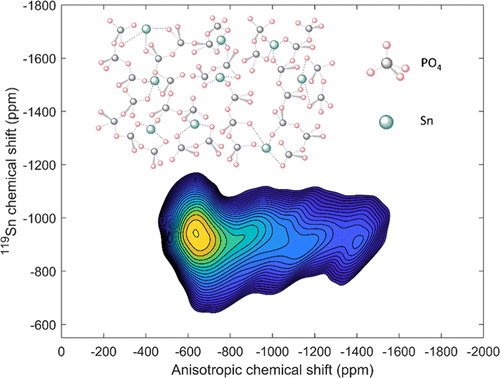当前位置:
X-MOL 学术
›
J. Phys. Chem. B
›
论文详情
Our official English website, www.x-mol.net, welcomes your
feedback! (Note: you will need to create a separate account there.)
Network Structure and Connectivity in SnO–P2O5 Glasses: Results from 2D 31P and 119Sn NMR Spectroscopy
The Journal of Physical Chemistry B ( IF 2.8 ) Pub Date : 2018-07-11 , DOI: 10.1021/acs.jpcb.8b04236 Yiqing Xia 1 , Maxwell A. T. Marple 1 , Ivan Hung 2 , Zhehong Gan 2 , Sabyasachi Sen 1
The Journal of Physical Chemistry B ( IF 2.8 ) Pub Date : 2018-07-11 , DOI: 10.1021/acs.jpcb.8b04236 Yiqing Xia 1 , Maxwell A. T. Marple 1 , Ivan Hung 2 , Zhehong Gan 2 , Sabyasachi Sen 1
Affiliation

|
The compositional evolution of the network structure and connectivity in binary SnO–P2O5 glasses with 35 ≤ mol % SnO ≤ 55 is studied using two-dimensional 119Sn and 31P NMR spectroscopy. The phosphate Qn species concentrations, as obtained from the analyses of the 31P NMR spectral line shapes suggest that the network modification can be described in terms of a binary Q-speciation model. On the other hand, the 119Sn NMR spectra suggest that the Sn–O coordination environment in these glasses is composition dependent. Sn is present in both 3-fold (trigonal pyramid) and 4-fold (trigonal bipyramid) coordinations with oxygen in these glasses. The relative fraction of the trigonal pyramidal environment increases with increasing SnO content. The unusually low glass transition temperature Tg of these glasses (241–266 °C) is argued to be related to the low coordination number of Sn, leading to a relatively sparsely connected structural network.
中文翻译:

SnO–P 2 O 5玻璃的网络结构和连通性:2D 31 P和119 Sn NMR光谱学的结果
使用二维119 Sn和31 P NMR光谱研究了35≤mol%SnO≤55的二元SnO-P 2 O 5玻璃的网络结构和连通性的组成演变。通过分析31 P NMR谱线形状获得的磷酸盐Q n物种浓度表明,可以根据二元Q物种模型描述网络修饰。另一方面,119Sn NMR光谱表明,这些玻璃中的Sn–O配位环境取决于成分。在这些玻璃中,Sn与氧以3倍(三角锥)和4倍(三角双锥)配位形式存在。三角锥体环境的相对分数随SnO含量的增加而增加。这些玻璃的玻璃化转变温度T g(241–266°C)异常低,据认为与Sn的低配位数有关,从而导致结构网络的连接相对稀疏。
更新日期:2018-07-12
中文翻译:

SnO–P 2 O 5玻璃的网络结构和连通性:2D 31 P和119 Sn NMR光谱学的结果
使用二维119 Sn和31 P NMR光谱研究了35≤mol%SnO≤55的二元SnO-P 2 O 5玻璃的网络结构和连通性的组成演变。通过分析31 P NMR谱线形状获得的磷酸盐Q n物种浓度表明,可以根据二元Q物种模型描述网络修饰。另一方面,119Sn NMR光谱表明,这些玻璃中的Sn–O配位环境取决于成分。在这些玻璃中,Sn与氧以3倍(三角锥)和4倍(三角双锥)配位形式存在。三角锥体环境的相对分数随SnO含量的增加而增加。这些玻璃的玻璃化转变温度T g(241–266°C)异常低,据认为与Sn的低配位数有关,从而导致结构网络的连接相对稀疏。











































 京公网安备 11010802027423号
京公网安备 11010802027423号